Have you ever wondered what difference various string gauges make to your tone? What strings you should use for drop C tuning? How often you should change your guitar strings? Well, you’ve come to the right place!
Here we’ll take a look at all things strings, from the different types you might encounter to how you should install and take care of them. After all, these twangy things play a huge part in creating your guitar’s tone and overall sound, so it’s definitely worth being clued up on them! Without further ado, here’s your comprehensive guide to electric guitar strings.
The main types of strings
First, let’s take a look at the main types of strings you’ll come across on your musical travels.
Acoustic strings
Designed specifically for acoustic guitars, these are usually made from steel and/or nickel, or even brass and bronze. They have a nice, bright tone with plenty of twang. And since they’re designed specifically for acoustics, they usually feature slightly thicker gauges than electric guitar strings.
Classical strings
Part of the acoustic family, but definitely the black sheep. Classical guitar strings are made from nylon, which gives them a completely different sound to metal strings. Designed solely for classical guitars, they have a much lighter, fluffier tone which is great for creating melodies.
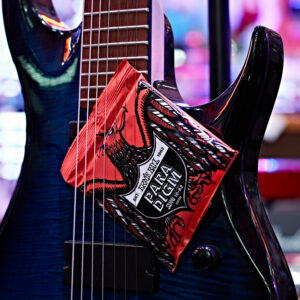 Electric strings
Electric strings
Like acoustic strings, these are also made from metal, but they have to contain magnetic materials like iron, cobalt, nickel, and steel. This is because electric guitars use magnetic pickups, which, using the movements from the magnetic strings, create an electric signal which is then transferred to an amp. They’re generally easier to play owing to the lower string gauge.
In this article, we’ll be looking at electric guitar strings, but it’s good to know which types are out there so you don’t get the wrong ones!
What does string gauge mean? String gauge refers to how thick a string is, and is usually shown like this: 0.11, 0.20, 0.48 and so on. The higher the number after the decimal point, the thicker the string.
On string packets, these may simply be written as whole numbers without the decimal.
Strings sets are also often referred to by the thinnest string to the thickest. For example, a set with 10, 13, 17, 26, 36, and 46 gauge strings would be known as 10-46s.
Gauging your strings’ potential
String gauges have a major impact on the feel and sound of your guitar. Luckily, it’s fairly easy to get your head around these. Here’s a quick breakdown of the different sets of string gauges and what they’re used for:
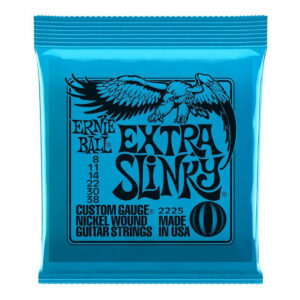 Light gauge
Light gauge
Really thin strings. On an electric, the gauge could be as low as 8-38s (like Ernie Ball’s Extra Slinky strings) or 9-42s.
Thinner strings are much easier to bend, making them great for bluesy playing. You also need less strength to press them down, which is good for legato and speedy playing. However, they’re also likely to snap easier, so tread light.
Medium gauge
A happy medium. These are used by many guitarists as they offer a nice balance between light and heavy gauges. Great all ’rounders, they suit any style of playing and standard tuning. 10-46s would be considered a standard medium gauge for electrics.
Heavy gauge
Chunky monkeys. As the name suggests, these strings are the thickest you’ll find, with gauges ranging from 12-54s to as high as 13-68s for an electric.
Now, there are a few advantages to using thicker strings. But the main reason for using such meaty twangers, and the reason metalheads love them, is because they’re perfect for drop tunings. Generally, the lower you go, the thicker the strings you’ll need for the extra tension (regular strings will feel like spaghetti in drop B). They require a little more strength to fret and bend though.
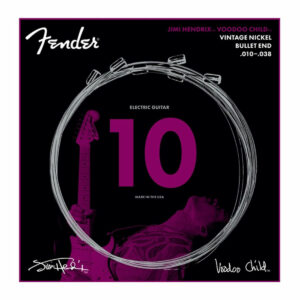 Hybrid/custom
Hybrid/custom
As you might expect, there’s also a myriad of hybrid string sets which combine different gauges if you’re a more discerning player.
These might include a heavy gauge on the lower strings and light on the top (like Fender’s Hendrix Voodoo Child set), or vice versa.
If you’re a more experienced player, it might be worth experimenting with some of these to find your ideal feel.
If you’re a beginner, you’re probably best off starting with regular gauge strings and moving from there (the majority of guitars you buy will come strung with these anyway).
In terms of tonality, you’ll probably find that lighter strings are a little brighter, whilst heavier strings offer a bit more warmth. However, the difference is generally very subtle.
How do I know which gauges to use? It depends on what style you’re playing and how you play. Are you a metalhead who likes to play aggressively and really dig into those chugs? Then you’ll probably want to use heavier gauge strings which are more durable. Are you a jazz musician who likes to play fast but light? Then lighter gauge strings will be your thing.
How often should you change your guitar strings?
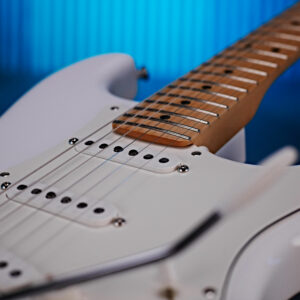 …the question on everyone’s mind. As you might imagine, it really depends on how much you actually play your guitar. First, though, it’s worth looking at what happens as you use your strings more and more, and they get older.
…the question on everyone’s mind. As you might imagine, it really depends on how much you actually play your guitar. First, though, it’s worth looking at what happens as you use your strings more and more, and they get older.
When you have a shiny new set of strings on your beloved guitar, you’ll notice that they have plenty of ‘snap’. This means they have a bright, clear tone and feel really smooth underneath your fingertips.
As you play them, they’ll naturally collect the sweat, dirt, and bacteria from your hands in their grooves (eurgh, I know, right?). Over time, this will start to degrade them, meaning they’ll lose their bright tone, sounding darker and muddier (this isn’t necessarily a bad thing if you like that sort of sound).
They’ll also lose their shine and won’t feel quite as responsive to your picking/plucking.
Strings naturally lose their durability as well. The more punishment they take, the more likely they are to snap. This is especially true if you’re hitting your strings hard and bending a lot.
So, just how often should you change your strings?
If you’re playing for a few hours per day, you’ll probably want to change your strings every month, especially if you want to preserve that bright tone and feel. On the other hand, if you only pick up your guitar occasionally, or play for less than an hour per day, you should find your strings last a fair bit longer, and you’ll only need to change them every two to three months.
Some players change their strings every few weeks, and, whilst this ensures you’ll always get that ‘new’ feel, it can also get fairly expensive. It all depends on how much you’re willing to spend on maintaining your guitar.
Got a gig coming up? Change your strings! The last thing you want is a breakage mid-performance. However, try to change them a few days prior in order to get them ‘played-in’. New strings often need some time for their tuning to settle down, as they need to be stretched in order to release pent-up tension (don’t we all).
Choose your weapon – different brands
So, now you know about guitar strings, how do you go about picking the right ones? With a myriad of different manufacturers out there, it’s easy for choice paralysis to set in. Luckily for you, you’re about to get a comprehensive breakdown of all the main players out there. Here we go:
Ernie Ball
One of the most recognisable string brands out there, Ernie Ball strings have funky, eye-catching packaging and have been around a long time. They offer tonnes of different options, including custom gauge sets. Ernie Ball is famed for pioneering thinner strings back in the ’60s, which made it much easier for youngsters and beginners to bend strings.
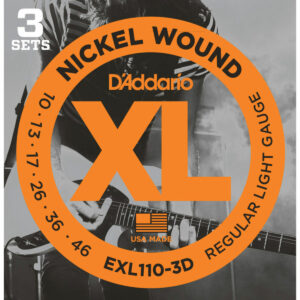 D’Addario
D’Addario
Having made strings since the 17th century, you’d expect D’Addario to have ample experience in string-making. You’d be right. Like Ernie Ball, they make tonnes of strings suited to different players. These include the NYXLs, which are designed to preserve tone and last longer.
Elixir
Of life. String life, to be precise. Elixirs have made a name for themselves across the world, and for good reason.
These hi-tech strings are pricier than their counterparts, but that’s because they’re coated in a special Optiweb, Nanoweb, or Polyweb. These highly advanced substances stop a lot of dirt and grime from getting into your strings, helping them maintain their fresh feel and brightness. They can potentially double string life as a result.
Dunlop
Keeping things simple. Dunlop don’t offer quite as many different string types as, say, Ernie Ball, but they make quality strings, and their packaging tells you exactly what they’re designed for. Their Heavy Core strings, for example, tell you that they’re designed for drop tunings. Useful!
Fender/PRS/Ibanez/Gibson
Some of the major guitar makers also make strings of their own, if you’re after that factory-fresh feel of a specific model.
Do different string materials change their tone? It’s hard to say, as the difference will be subtle at best. String gauges are far more likely to have an impact on your tone, with thicker strings touted to sound darker and fuller and lighter gauges sounding bright and twangy.
String installation
The time has come to put your new set in. But how do you do that? It’s fairly simple. And here are a few things which might make your job easier:
Wire/string cutters
These will be a lifesaver when it comes to removing your old strings and trimming the ends off your new set. After all, strings are sharp, so you’ll want to keep them short at the headstock end to avoid them getting in the way.
String winder
Not a necessity but definitely a time-saver, string winders attach to the tuning pegs and let you wind your strings up really fast.
Stretcher
Stretching your strings out is a great way to stabilise their tuning – new strings have a habit of regularly going out of tune when you first install them. Using a quality string stretcher will let you do this with ease. Or you can tune them slightly sharp and keep adjusting until the tuning stops changing, but this will take a bit of time.
 To install your new strings, you’ll first want to remove your old ones. The easiest way to do this is to slacken them a bit with the tuning peg, then just cut straight through with wire cutters. Safely remove them from the bridge and headstock and dispose of them safely.
To install your new strings, you’ll first want to remove your old ones. The easiest way to do this is to slacken them a bit with the tuning peg, then just cut straight through with wire cutters. Safely remove them from the bridge and headstock and dispose of them safely.
One at a time, take one of the new strings from your set and thread the cut-off end through the bridge or body. Different guitars will have different bridge setups, but generally, you’ll need to put the strings through the holes in the back of the body. Take a look at how the previous strings were set up to get an idea.
Pull the string through, all the way to the headstock, leaving a couple of inches of give – then check that it’s sitting in the groove of the nut. Make sure the hole of the tuning peg is facing directly upwards (and downwards). Thread it through the relevant tuning peg from underneath, (you can wrap it around first if you like, but this isn’t strictly necessary, and you definitely don’t need to do it if you have locking tuners).
If you have locking tuners, you’ll need to loosen the locking nut at the back of the tuning peg before you can thread the string through. Once it’s in, you’ll then need to tighten up the locking nut to lock the string in (for all the pegs).
Once you’ve got your strings in and tightened them up by twisting the tuning pegs, you can then snip the ends off with your wire cutters. Hey presto – you’ve got new strings on your guitar!
Be careful! Take your time – you can easily snap a string if you tighten it too much. Make sure you’re using a tuner and you know the exact tuning you’re going for (standard tuning is EADGBE from thickest string to thinnest).
Love them or lose them – how to care for your guitar strings
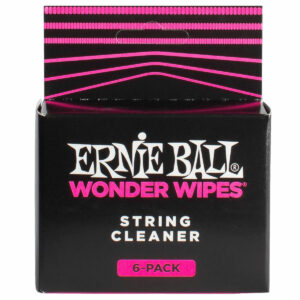 Getting new strings is one thing, but ensuring they always give the best performance is another. Luckily, there are some useful bits of kit you could consider if you want to keep them in pristine condition and singing smoothly.
Getting new strings is one thing, but ensuring they always give the best performance is another. Luckily, there are some useful bits of kit you could consider if you want to keep them in pristine condition and singing smoothly.
By now you’ve probably gathered that strings get gunked up pretty easily (if you haven’t, what else have you been reading?).
Some string cleaner will sort them right out. All you need is a cloth (preferably microfiber), and then you can really go to town on those dirty strings.
Try to clean them after every extended practice session or rehearsal, especially those sweaty summer ones. This’ll help keep your strings’ performance stellar and preserve their tone for longer.
Find out more
So, there you have it, pretty much everything you’ll ever need to know about electric guitar strings. Why not check out our full range?













0 Comments